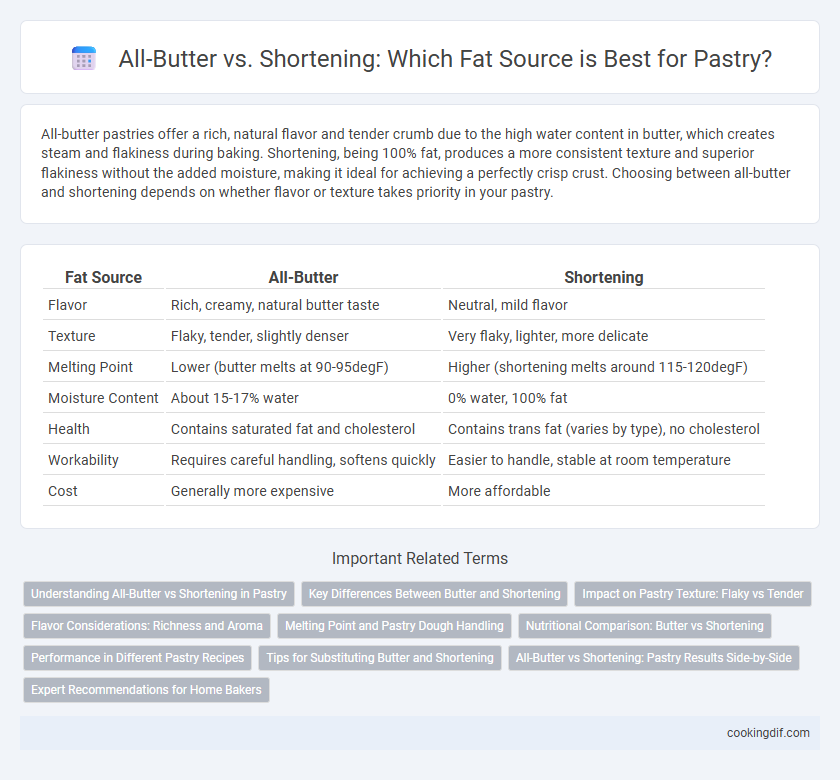All-butter pastries offer a rich, natural flavor and tender crumb due to the high water content in butter, which creates steam and flakiness during baking. Shortening, being 100% fat, produces a more consistent texture and superior flakiness without the added moisture, making it ideal for achieving a perfectly crisp crust. Choosing between all-butter and shortening depends on whether flavor or texture takes priority in your pastry.
Table of Comparison
| Fat Source | All-Butter | Shortening |
|---|---|---|
| Flavor | Rich, creamy, natural butter taste | Neutral, mild flavor |
| Texture | Flaky, tender, slightly denser | Very flaky, lighter, more delicate |
| Melting Point | Lower (butter melts at 90-95degF) | Higher (shortening melts around 115-120degF) |
| Moisture Content | About 15-17% water | 0% water, 100% fat |
| Health | Contains saturated fat and cholesterol | Contains trans fat (varies by type), no cholesterol |
| Workability | Requires careful handling, softens quickly | Easier to handle, stable at room temperature |
| Cost | Generally more expensive | More affordable |
Understanding All-Butter vs Shortening in Pastry
All-butter pastries offer a rich, natural flavor and tender crumb due to the high water content in butter that creates steam during baking, resulting in flaky layers. Shortening, being 100% fat, produces a more tender and less greasy texture with a higher melting point that enhances dough handling and shelf life. Choosing between all-butter and shortening depends on the desired balance of flavor, texture, and ease of preparation in pastry applications.
Key Differences Between Butter and Shortening
Butter contains about 80% fat and 15-17% water, providing rich flavor and contributing to flakiness through steam formation during baking. Shortening is 100% fat with no water, resulting in a tender, crumbly texture but a less pronounced taste. The higher melting point of shortening helps pastries hold their shape better, while butter's natural milk solids promote browning and a golden crust.
Impact on Pastry Texture: Flaky vs Tender
All-butter pastry creates a rich, flaky texture due to the butter's water content producing steam during baking, which separates the layers. Shortening-based pastry yields a more tender, crumbly texture because shortening's higher melting point prevents excessive spreading and limits gluten formation. Choosing butter enhances flavor complexity and flakiness, while shortening prioritizes a soft, tender bite and ease of handling.
Flavor Considerations: Richness and Aroma
All-butter pastries deliver a rich, creamy flavor and a distinctive, aromatic quality that enhances the overall taste profile, prized by bakers for its natural dairy essence. Shortening provides a more neutral taste, allowing other ingredients to shine without competing aromas, while contributing to a tender and flaky texture. The choice between all-butter and shortening significantly impacts the pastry's richness and aromatic intensity, influencing the final sensory experience.
Melting Point and Pastry Dough Handling
All-butter pastry dough melts at a lower temperature due to butter's melting point around 90-95degF, creating a tender, flaky texture but requiring careful handling to prevent softness and stickiness. Shortening has a higher melting point near 115-130degF, offering easier dough manipulation and increased plasticity, resulting in a sturdier, crisper crust. Choosing between all-butter and shortening impacts dough elasticity, workability, and final pastry mouthfeel, with butter providing rich flavor and shortening improving dough stability.
Nutritional Comparison: Butter vs Shortening
Butter contains approximately 80% fat, predominantly saturated fat, and provides essential fat-soluble vitamins A, D, E, and K, contributing to a richer nutritional profile compared to shortening. Shortening is 100% fat, composed mainly of trans fats or unsaturated fats depending on the type, often lacking vitamins and potentially linked to higher cardiovascular risks. Choosing butter over shortening enhances the pastry's flavor and nutritional benefits by incorporating natural fats and fat-soluble nutrients.
Performance in Different Pastry Recipes
All-butter pastries offer superior flavor and create flakier, more tender textures due to butter's water content which generates steam during baking. Shortening provides higher melting points, resulting in more stable doughs that are easier to handle and produce consistently puffier pastries, especially in high-heat recipes. Selecting the fat source depends on the desired texture: use butter for rich, flavorful pastries like croissants, and shortening for sturdier, flaky biscuits or pie crusts needing structure.
Tips for Substituting Butter and Shortening
Replacing shortening with all-butter in pastries enhances flavor and creates a flakier texture due to butter's water content, but requires adjusting for moisture by slightly reducing liquid ingredients. When substituting butter for shortening, use a 1:1 ratio but consider chilling the dough to prevent excessive spreading during baking. To maintain tenderness and structure, combine butter with a small amount of shortening or use high-fat European butter to mimic shortening's fat content.
All-Butter vs Shortening: Pastry Results Side-by-Side
All-butter pastry delivers a rich, natural flavor and tender, flaky texture due to its high water content that creates steam during baking, enhancing lift and crispness. Shortening-based pastry yields a more uniform, tender crumb with less shrinkage and a higher melting point, resulting in a softer, more pliable dough ideal for consistent shaping and durability. Side-by-side, all-butter pastries offer superior flavor and flakiness, while shortening pastries excel in ease of handling and structural stability during baking.
Expert Recommendations for Home Bakers
Expert recommendations for home bakers emphasize using all-butter for its superior flavor and natural moisture, which enhance the pastry's texture and taste. Shortening offers increased flakiness and a higher melting point, resulting in a more tender crust, ideal for specific recipes needing structure and less spreading. Combining both fats can optimize balance between flavor and texture, adapting to individual recipe requirements and baking conditions.
All-butter vs Shortening for fat source Infographic

 cookingdif.com
cookingdif.com